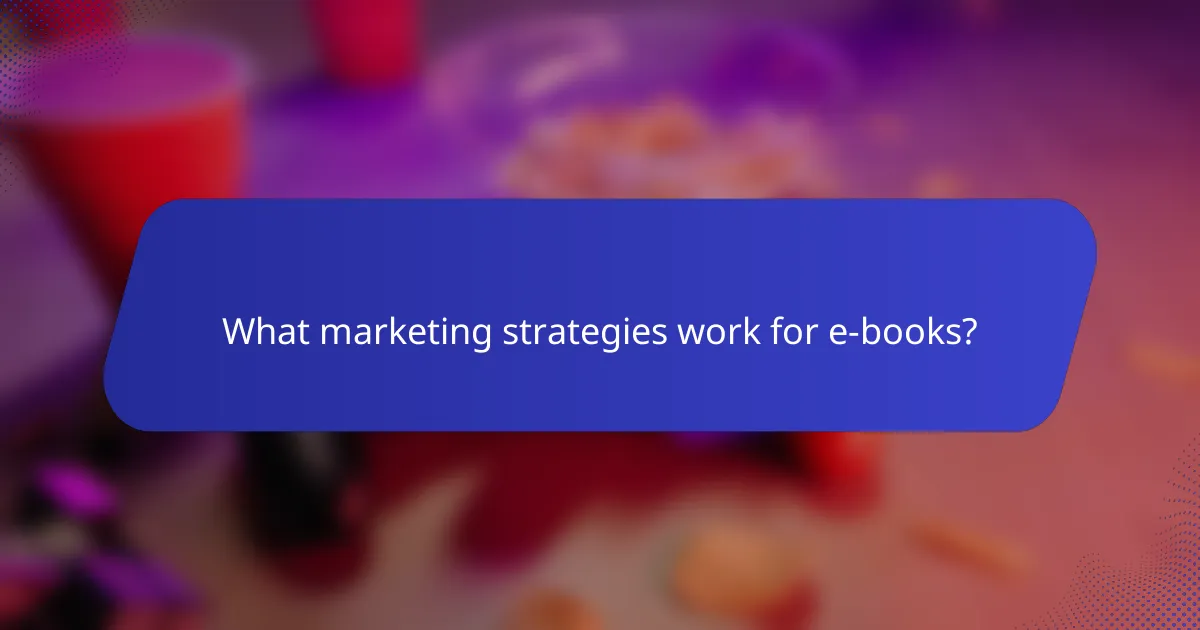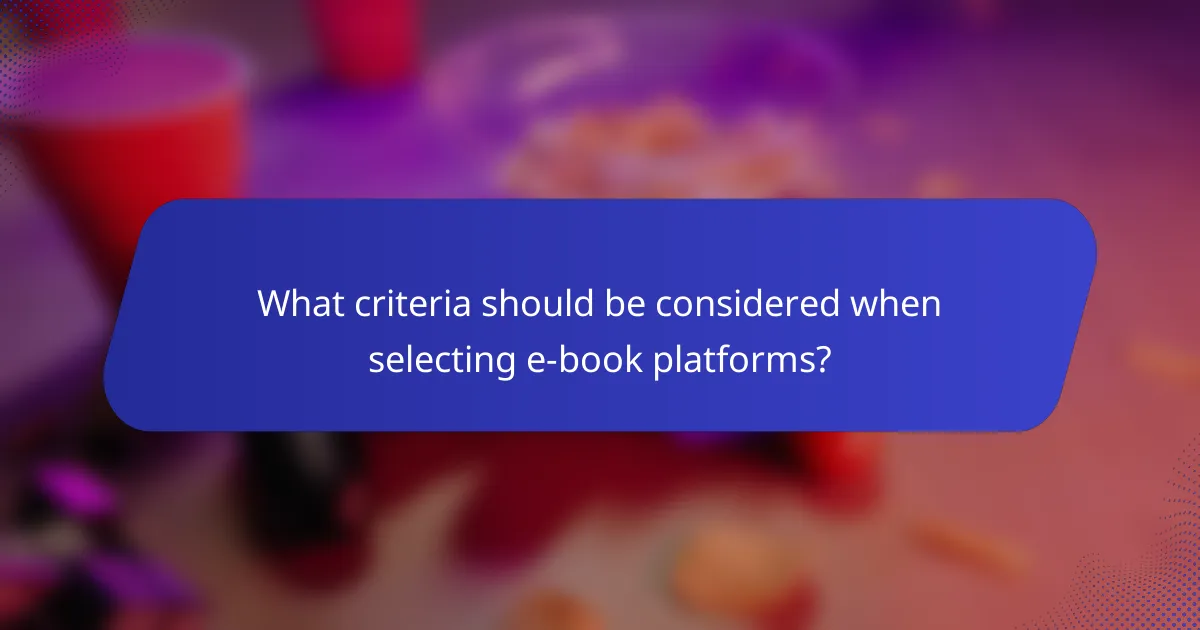The e-book market faces challenges such as content saturation, making it essential for authors and publishers to deliver unique insights that resonate with their target audience. Effective marketing strategies, including social media and influencer partnerships, are crucial for enhancing visibility and driving sales. Additionally, a well-researched pricing strategy that considers market trends and production costs can significantly impact profitability.

How to overcome content saturation in e-books?
To overcome content saturation in e-books, focus on delivering unique insights and tailored experiences that stand out in a crowded market. This involves understanding your audience deeply and providing them with content that addresses their specific needs and interests.
Unique value propositions
Establishing a unique value proposition (UVP) is crucial for differentiating your e-book from others. A strong UVP clearly communicates what makes your content special, whether it’s exclusive research, a unique perspective, or practical applications. For example, an e-book on digital marketing could offer case studies from lesser-known brands that achieved success without large budgets.
Consider using compelling language and visuals to highlight your UVP on the cover and in promotional materials. This will help potential readers quickly grasp what they will gain from your e-book.
Niche targeting strategies
Niche targeting involves focusing your e-book on a specific segment of the market, which can reduce competition and increase relevance. Identify underserved topics or audiences within your field and tailor your content to meet their unique needs. For instance, instead of writing a general fitness e-book, you could focus on fitness for busy professionals.
Utilize social media platforms and online forums to engage with your target audience and gather insights about their preferences. This will help you create content that resonates and drives sales.
Leveraging multimedia elements
Incorporating multimedia elements such as videos, infographics, and interactive quizzes can enhance the reader’s experience and make your e-book more engaging. These elements can help clarify complex concepts and provide additional value, making your content more appealing in a saturated market.
Ensure that multimedia elements are relevant and seamlessly integrated into the text. For example, a cooking e-book could include video demonstrations of recipes, allowing readers to follow along more easily.
Collaborative content creation
Collaborating with other authors or experts can enrich your e-book and expand your audience. By co-authoring or featuring guest contributions, you can provide diverse perspectives and insights that enhance the overall quality of your content. This approach can also help you tap into the collaborator’s audience, increasing your reach.
Choose collaborators who align with your brand and share similar values to ensure a cohesive message throughout the e-book.
Regular updates and revisions
Regularly updating and revising your e-book can keep it relevant and valuable in a fast-changing landscape. Consider setting a schedule for reviews, such as every six months or annually, to incorporate new information, trends, or reader feedback.
Communicate updates to your audience, possibly offering them at a discounted rate or for free to existing customers. This not only retains customer loyalty but also positions your e-book as a trusted resource in its field.

What marketing strategies work for e-books?
Effective marketing strategies for e-books include leveraging social media, email campaigns, influencer partnerships, and content marketing. Each approach can enhance visibility and drive sales, but requires careful execution to maximize impact.
Social media advertising
Social media advertising is a powerful tool for promoting e-books, allowing authors and publishers to target specific demographics. Platforms like Facebook, Instagram, and Twitter offer various ad formats, including sponsored posts and stories, which can effectively capture attention.
To optimize social media ads, focus on eye-catching visuals and compelling copy. Consider setting a budget that allows for testing different ad sets to determine which resonates best with your audience. Aim for a cost-per-click (CPC) that aligns with your overall marketing budget.
Email marketing campaigns
Email marketing campaigns are essential for building a direct relationship with potential readers. By collecting email addresses through sign-up forms or landing pages, you can create targeted campaigns that promote your e-book launches, special offers, or exclusive content.
To enhance effectiveness, segment your email list based on reader interests and behaviors. Personalization can significantly improve open and click-through rates. Regularly analyze campaign performance to refine your approach and maximize engagement.
Influencer partnerships
Influencer partnerships can amplify your e-book’s reach by leveraging the established audiences of popular figures in your genre. Collaborating with influencers for reviews, giveaways, or social media takeovers can generate buzz and credibility.
When selecting influencers, consider their audience demographics and engagement rates. Aim for micro-influencers who often have more dedicated followers and may charge lower fees. Establish clear expectations and deliverables to ensure a successful partnership.
Content marketing through blogs
Content marketing through blogs can drive organic traffic to your e-book by providing valuable information related to your book’s themes. Writing articles that address reader interests or challenges can position you as an authority in your niche.
Incorporate SEO best practices to enhance visibility in search engines. Use relevant keywords, optimize meta descriptions, and include links to your e-book. Regularly update your blog to keep content fresh and engaging for returning visitors.

How to price e-books effectively?
To price e-books effectively, consider market trends, production costs, and perceived value. A well-researched pricing strategy can enhance sales and ensure profitability.
Competitive analysis
Conducting a competitive analysis involves researching similar e-books in your genre to understand their pricing. Look at bestsellers and average prices to identify a suitable range, typically between $2.99 and $9.99 for most genres. Take note of any promotional pricing or discounts offered by competitors.
Utilize platforms like Amazon Kindle or Apple Books to gather data on pricing strategies. Pay attention to customer reviews and ratings, as these can indicate how price influences perceived value.
Value-based pricing
Value-based pricing focuses on the perceived value of your e-book to the target audience rather than just production costs. Assess the unique benefits your e-book offers, such as exclusive content or expert insights, which can justify a higher price point. For example, niche topics may command higher prices if they provide specialized knowledge.
Engage with your audience through surveys or feedback to gauge their willingness to pay. This approach helps align your pricing with customer expectations and enhances satisfaction.
Discount strategies
Implementing discount strategies can boost sales and attract new readers. Consider offering limited-time discounts or bundling your e-book with other products to create perceived value. For instance, a 20% discount during a launch week can encourage early purchases.
Be cautious with frequent discounts, as they may devalue your e-book in the long run. Instead, use discounts strategically during promotional events or holidays to maximize impact without compromising perceived worth.

What are the key challenges in e-book marketing?
The key challenges in e-book marketing include audience engagement, visibility in crowded markets, and conversion rate optimization. These factors significantly impact an author or publisher’s ability to reach potential readers and drive sales.
Audience engagement
Engaging an audience is crucial for e-book marketing success. Authors must create compelling content that resonates with their target demographic, often requiring a deep understanding of reader preferences and behaviors.
Utilizing social media platforms, email newsletters, and interactive content can enhance engagement. For instance, hosting live Q&A sessions or offering exclusive content can foster a community around the e-book.
Visibility in crowded markets
With thousands of e-books released regularly, gaining visibility is a significant hurdle. Authors should leverage multiple marketing channels, including social media advertising, search engine optimization (SEO), and partnerships with influencers to stand out.
Consider using promotional strategies like limited-time discounts or free chapters to attract attention. Regularly updating keywords and descriptions can also improve discoverability on platforms like Amazon and Google Books.
Conversion rate optimization
Optimizing conversion rates is essential for turning potential readers into buyers. This involves analyzing user behavior on sales pages and making adjustments to improve the purchasing process.
Key strategies include simplifying the checkout process, using persuasive copy, and incorporating reviews or testimonials. A/B testing different cover designs or pricing strategies can also provide insights into what resonates best with the audience.

What criteria should be considered when selecting e-book platforms?
When selecting e-book platforms, consider factors such as user interface, distribution reach, and revenue sharing models. Each of these elements can significantly impact your e-book’s visibility, sales potential, and overall user experience.
User interface and experience
The user interface (UI) and overall experience are crucial for both authors and readers. A clean, intuitive design can enhance reader engagement and satisfaction, which may lead to better reviews and repeat purchases. Look for platforms that offer easy navigation, customizable reading settings, and responsive design for various devices.
Additionally, consider the onboarding process for authors. A platform that simplifies uploading and formatting can save time and reduce frustration. Check for user reviews or demos to gauge the quality of the interface before committing.
Distribution reach
Distribution reach refers to how widely your e-book can be sold across different markets. A platform with extensive partnerships can help your book reach a larger audience, including international markets. Evaluate whether the platform distributes to major retailers, libraries, and other channels that align with your target audience.
Some platforms may focus on specific regions or demographics, so it’s essential to match your e-book’s genre and target market with the platform’s distribution capabilities. Consider platforms that offer global reach if you aim to attract readers from various countries.
Revenue sharing models
Revenue sharing models determine how much of your sales revenue you keep after the platform takes its cut. Most platforms operate on a percentage basis, typically ranging from 30% to 70% of the sale price. Understanding these percentages is vital for calculating your potential earnings.
Be aware of any additional fees, such as listing or transaction fees, which can affect your overall profit. Compare models across different platforms to find one that aligns with your financial goals, and consider how pricing strategies may influence your revenue in competitive markets.
